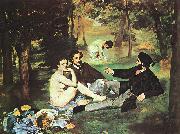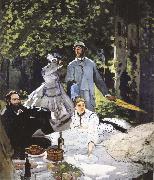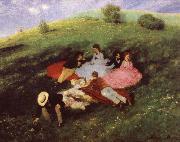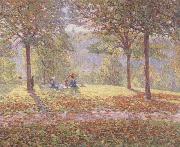Wholesale Oil Painting No Minimum |
|||||||||||
|
|
|||||||||||

|
|||||||||||
|
|
|
||||||||
Edouard ManetFrench Realist/Impressionist Painter, 1832-1883 The roughly painted style and photographic lighting in these works was seen as specifically modern, and as a challenge to the Renaissance works Manet copied or used as source material. His work is considered 'early modern', partially because of the black outlining of figures, which draws attention to the surface of the picture plane and the material quality of paint. He became friends with the Impressionists Edgar Degas, Claude Monet, Pierre-Auguste Renoir, Alfred Sisley, Paul Cezanne, and Camille Pissarro, through another painter, Berthe Morisot, who was a member of the group and drew him into their activities. The grand niece of the painter Jean-Honor?? Fragonard, Morisot's paintings first had been accepted in the Salon de Paris in 1864 and she continued to show in the salon for ten years. Manet became the friend and colleague of Berthe Morisot in 1868. She is credited with convincing Manet to attempt plein air painting, which she had been practicing since she had been introduced to it by another friend of hers, Camille Corot. They had a reciprocating relationship and Manet incorporated some of her techniques into his paintings. In 1874, she became his sister-in-law when she married his brother, Eugene. Self-portrait with palette, 1879Unlike the core Impressionist group, Manet maintained that modern artists should seek to exhibit at the Paris Salon rather than abandon it in favor of independent exhibitions. Nevertheless, when Manet was excluded from the International exhibition of 1867, he set up his own exhibition. His mother worried that he would waste all his inheritance on this project, which was enormously expensive. While the exhibition earned poor reviews from the major critics, it also provided his first contacts with several future Impressionist painters, including Degas. Although his own work influenced and anticipated the Impressionist style, he resisted involvement in Impressionist exhibitions, partly because he did not wish to be seen as the representative of a group identity, and partly because he preferred to exhibit at the Salon. Eva Gonzal??s was his only formal student. He was influenced by the Impressionists, especially Monet and Morisot. Their influence is seen in Manet's use of lighter colors, but he retained his distinctive use of black, uncharacteristic of Impressionist painting. He painted many outdoor (plein air) pieces, but always returned to what he considered the serious work of the studio. Manet enjoyed a close friendship with composer Emmanuel Chabrier, painting two portraits of him; the musician owned 14 of Manet's paintings and dedicated his Impromptu to Manet's wife. Throughout his life, although resisted by art critics, Manet could number as his champions Emile Zola, who supported him publicly in the press, Stephane Mallarme, and Charles Baudelaire, who challenged him to depict life as it was. Manet, in turn, drew or painted each of them. |
||||||||
|
|
||||||||
Luncheon on the Grass
Luncheon on the Grass Painting ID:: 2671 |
1863 1863 |
|||||||
|
|
||||||||
Claude MonetFrench Impressionist Painter, 1840-1926 Claude Oscar Monet (14 November 1840 C 5 December 1926) was a founder of French impressionist painting, and the most consistent and prolific practitioner of the movement's philosophy of expressing one's perceptions before nature, especially as applied to plein-air landscape painting. The term Impressionism is derived from the title of his painting. Claude Monet was born on 14 November 1840 on the fifth floor of 45 rue Laffitte, in the ninth arrondissement of Paris . He was the second son of Claude-Adolphe and Louise-Justine Aubree Monet, both of them second-generation Parisians. On 20 May 1841, he was baptised into the local church parish, Notre-Dame-de-Lorette as Oscar-Claude. In 1845, his family moved to Le Havre in Normandy. His father wanted him to go into the family grocery store business, but Claude Monet wanted to become an artist. His mother was a singer. On the first of April 1851, Monet entered the Le Havre secondary school of the arts. He first became known locally for his charcoal caricatures, which he would sell for ten to twenty francs. Monet also undertook his first drawing lessons from Jacques-François Ochard, a former student of Jacques-Louis David. On the beaches of Normandy in about 1856/1857 he met fellow artist Eugene Boudin who became his mentor and taught him to use oil paints. Boudin taught Monet "en plein air" (outdoor) techniques for painting. On 28 January 1857 his mother died. He was 16 years old when he left school, and went to live with his widowed childless aunt, Marie-Jeanne Lecadre. After several difficult months following the death of Camille on 5 September 1879, a grief-stricken Monet (resolving never to be mired in poverty again) began in earnest to create some of his best paintings of the 19th century. During the early 1880s Monet painted several groups of landscapes and seascapes in what he considered to be campaigns to document the French countryside. His extensive campaigns evolved into his series' paintings. Camille Monet had become ill with tuberculosis in 1876. Pregnant with her second child she gave birth to Michel Monet in March 1878. In 1878 the Monets temporarily moved into the home of Ernest Hosched, (1837-1891), a wealthy department store owner and patron of the arts. Both families then shared a house in Vetheuil during the summer. After her husband (Ernest Hoschede) became bankrupt, and left in 1878 for Belgium, in September 1879, and while Monet continued to live in the house in Vetheuil; Alice Hosched helped Monet to raise his two sons, Jean and Michel, by taking them to Paris to live alongside her own six children. They were Blanche, Germaine, Suzanne, Marthe, Jean-Pierre, and Jacques. In the spring of 1880 Alice Hosched and all the children left Paris and rejoined Monet still living in the house in Vetheuil. In 1881 all of them moved to Poissy which Monet hated. From the doorway of the little train between Vernon and Gasny he discovered Giverny. In April 1883 they moved to Vernon, then to a house in Giverny, Eure, in Upper Normandy, where he planted a large garden where he painted for much of the rest of his life. Following the death of her estranged husband, Alice Hosched married Claude Monet in 1892. |
||||||||
|
|
||||||||
|
|
Luncheon on the Grass
Luncheon on the Grass Painting ID:: 49462 |
mk196
central panel
1865-66
mk196 central panel 1865-66 |
||||||
|
|
||||||||
Merse, Pal SzinyeiHungarian Painter, 1845-1920 was a Hungarian painter and politician. Born in Szinye??jfalu, Hungary (today Chminianska Nov?? Ves, Slovakia), he learned painting at the Academy of Fine Arts, Munich under Karl von Piloty. He was a friend of Wilhelm Leibl and Hans Makart. His are some of the earliest works of Impressionism in Hungary and Central Europe. At the 1873 World's Fair in Vienna he won a medal with his painting Bath House. Szinyei was also an active politician. He was elected to the parliament of Hungary where he fought for the modernization of art education. He died in February 2, 1920, just four month and two days before the Trianon treaty, in Jarovnice |
||||||||
|
|
||||||||
|
|
Luncheon on the Grass
Luncheon on the Grass Painting ID:: 54390 |
mk235
1873
Oil on canvas
mk235 1873 Oil on canvas |
||||||
|
|
||||||||
Wynford DewhurstBritish, 1864-1941 Wynford Dewhurst was born in Manchester in 1864. He was educated at home by a private tutor and later at Mintholme College. Although he originally trained to enter the legal profession, he showed artistic flair and decided to pursue a career as a painter after some of his drawings were published in various journals. He gained his artistic training in France at the Ecole des Beaux-Arts, in Paris, where he was a pupil of the renowned French painter Jean-L??on Gerome. Despite his teacher Gerome rejection of the radical Impressionist movement in favour of a highly finished academic style (Gerome continued the development and conservation of French Neoclassicism), Dewhurst was heavily influenced by the Impressionists. It is well known that he first encountered Impressionism, to which he was instantly attracted, in the work of Emile Claus in the Maddocks Collection in Bradford. However his most important mentor would become Claude Monet. It was Monet to whom Dewhurst dedicated his pioneering account of French Impressionism, Impressionist Painting: its genesis and development, in 1904. This was the first important study of the French painters to be published in English. As well as helping to reintroduce British artists to this style of painting, Dewhurst book called attention to the French Impressionists debt to the British artists John Constable and J. M. W. Turner, claiming that the Impressionists simply developed their existing painterly techniques. According to Dewhurst, artists who, like himself, painted in an impressionist manner, were often sneered at for imitating a foreign style, and he was keen to justify their position. French artists simply developed a style which was British in its conception, he wrote, a view that was dismissed by some French painters - such as Pissarro - who revealed his national bias when he acknowledged Constable and Turner but identified instead French influences like Nicolas Poussin, Claude Lorrain, Jean-Baptiste-Sim??on Chardin and Jean-Baptiste-Camille Corot. The thesis that Dewhurst put forward in Impressionist Painting was controversial for it dealt with the debated question of whether Impressionism was French or British in origin. However, it found much support in Britain: Kevin McConkey informs us that Dewhurst theme was taken up by others as various as Clausen, John Rothenstein and Kenneth Clark Nevertheless, Dewhurst detailed biographical notices of the most prominent artists associated with the rise of impressionism in France...leave little to be desired from the historical point of view. It is worth noting that Impressionist Painting also included an entire chapter on female artists, since modernity is the note of Impressionism, and that movement was the very first artistic revolt in which women took part. Indeed, Dewhurst thanks the celebrated female painter Mary Cassatt (who worked within the Impressionist circle) for her assistance in the preface of his book. |
||||||||
|
|
||||||||
|
|
Luncheon on the Grass
Luncheon on the Grass Painting ID:: 54448 |
mk235
1908
Oil on canvas
82x100.7cm
mk235 1908 Oil on canvas 82x100.7cm |
||||||
|
|
||||||||
|
Wynford Dewhurst British, 1864-1941 Wynford Dewhurst was born in Manchester in 1864. He was educated at home by a private tutor and later at Mintholme College. Although he originally trained to enter the legal profession, he showed artistic flair and decided to pursue a career as a painter after some of his drawings were published in various journals. He gained his artistic training in France at the Ecole des Beaux-Arts, in Paris, where he was a pupil of the renowned French painter Jean-L??on Gerome. Despite his teacher Gerome rejection of the radical Impressionist movement in favour of a highly finished academic style (Gerome continued the development and conservation of French Neoclassicism), Dewhurst was heavily influenced by the Impressionists. It is well known that he first encountered Impressionism, to which he was instantly attracted, in the work of Emile Claus in the Maddocks Collection in Bradford. However his most important mentor would become Claude Monet. It was Monet to whom Dewhurst dedicated his pioneering account of French Impressionism, Impressionist Painting: its genesis and development, in 1904. This was the first important study of the French painters to be published in English. As well as helping to reintroduce British artists to this style of painting, Dewhurst book called attention to the French Impressionists debt to the British artists John Constable and J. M. W. Turner, claiming that the Impressionists simply developed their existing painterly techniques. According to Dewhurst, artists who, like himself, painted in an impressionist manner, were often sneered at for imitating a foreign style, and he was keen to justify their position. French artists simply developed a style which was British in its conception, he wrote, a view that was dismissed by some French painters - such as Pissarro - who revealed his national bias when he acknowledged Constable and Turner but identified instead French influences like Nicolas Poussin, Claude Lorrain, Jean-Baptiste-Sim??on Chardin and Jean-Baptiste-Camille Corot. The thesis that Dewhurst put forward in Impressionist Painting was controversial for it dealt with the debated question of whether Impressionism was French or British in origin. However, it found much support in Britain: Kevin McConkey informs us that Dewhurst theme was taken up by others as various as Clausen, John Rothenstein and Kenneth Clark Nevertheless, Dewhurst detailed biographical notices of the most prominent artists associated with the rise of impressionism in France...leave little to be desired from the historical point of view. It is worth noting that Impressionist Painting also included an entire chapter on female artists, since modernity is the note of Impressionism, and that movement was the very first artistic revolt in which women took part. Indeed, Dewhurst thanks the celebrated female painter Mary Cassatt (who worked within the Impressionist circle) for her assistance in the preface of his book. Luncheon on the Grass mk235 1908 Oil on canvas 82x100.7cm |
||||||||
|
|
||||||||
|
Prev Next
|
||||||||
|
|
||||||||
|
Related Paintings to Wynford Dewhurst :. |
||||||||
|
|
||||||||
|
CONTACT US |




